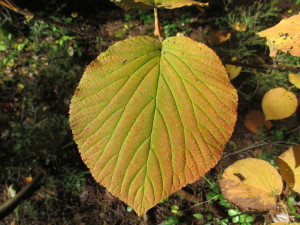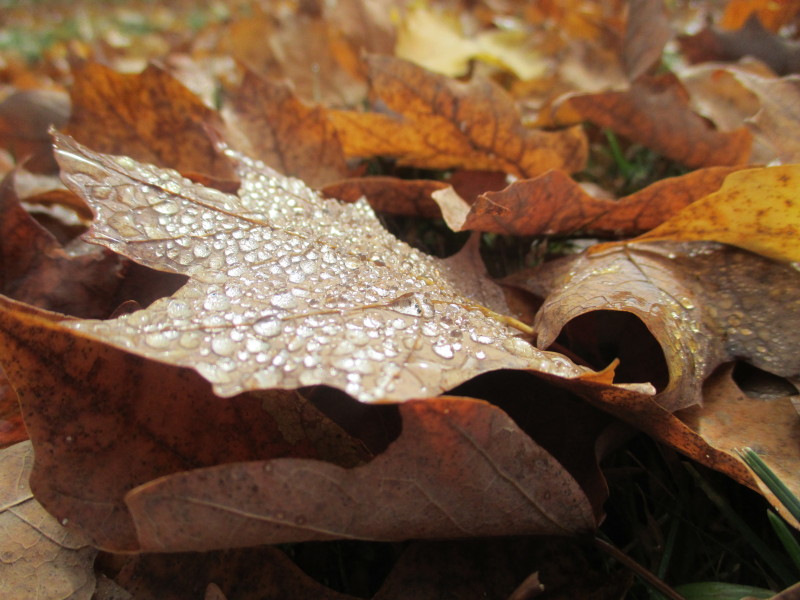SEASONAL GYRE: PHENOLOGY COMES ALIVE AT THE HARVARD FOREST
Fall is at its peak at the Harvard Forest and John O’Keefe, my collaborator on the Witness Tree project, and I have been keeping close track on the progression of the color and fall of the leaves. Called phenology, this study of the seasonal changes in nature is one of the oldest written biological records, and it has new relevance in the era of global climate change.
The phenological phase of the forest – whether it is budding out, leafing, or the leaves are coloring and falling, is a proxy for the productivity of the forest: when it is switched on, revving up, working at top speed, slowing down, and switched off.

Fall colors are ablaze in the forest

Hobblebush, a lovely understory native plant, glows with shades of cantaloupe and lemon.
Phenology is also a powerful lens on the effects of climate change. By tracking the same trees at the Harvard Forest for 25 years, John knows that on average, spring is earlier, and fall later than it used to be – making for a longer growing season. That in turn means more C02 sucked out of the atmosphere by trees – and some trees are growing bigger and faster than ever.
That includes BT QURU 03: the tagged, tracked red oak in John’s circuit of monitored trees – and the main character in my book underway here at the forest, Witness Tree.
John started his autumn phenology walks on September 1, and we go out once a week, making close observations of the foliage. We’ll keep at it until about Thanksgiving, when the leaves are off the trees. Then we’ll start up again come spring.
This last few weeks has been a building symphony of color, as fall has gradually settled in – then, since the Equinox, amped up.
The trees have become incandescent, and walking in the forest is like being under the stained glass shade of a Tiffany lamp. Yellow, orange, crimson, umber, and every shade in between light our forest path.
From giant sugar maples aglow 200 feet in the air to the understory lamplight of the striped maple’s pale yellow leaves, and almost unbelievable red of the maples, black gums, and an unaccountably vivid cluster of red oak I spied this week, the forest is changing every hour.
The fall rains have begun, and rainwater puddles in the cupped leaves, creating prisms and mirroring the sky above. Or it sparkles in lenses scattered in droplets all over their surface.
rains have begun, and rainwater puddles in the cupped leaves, creating prisms and mirroring the sky above. Or it sparkles in lenses scattered in droplets all over their surface.
A fall rain becomes a shower of diamonds on fallen maple leaves
The dark headwater divide of two streams we cross in the gloom of the Hemlock Hollow is bejeweled with autumn leaves.

The leaves of black gum are the brightest in the forest, but also the most fleeting in their beauty. The foliage typically colors and falls in just a matter of days.
And the forest floor is alive with salamanders, out and about on the forest floor with a regal bearing.
And the mushrooms! They came with the first fall rains and stud the forest floor with fanciful shapes, from slimy shiny to velvety caps that invite a cook’s assessment.
We’ve feasted on mushrooms sautéed on pasta. Cooked up mushrooms in gumbo and curried in cream of mushroom soup. And I’m sure there will be more experimentation to come. Let’s just say I am keeping a quart of heavy cream on hand in the fridge. By all means, send recipes.
As my second month here at the forest unfolds, I feel I am becoming the forest. I eat its mushrooms; crunch its leaves underfoot, in my hair, and in my house. I pick caterpillars looking for a nice place to spin a cocoon off the couch, and watch a spider rappel down silk from my glasses. I am awed at the call of a screech owl, from deep in the forest dark, coming so much earlier now. And delighted at the joy of something I had long forgotten: the fragrance and crisp crunch of kicking through brilliant windrows of fallen leaves.

Leave a Reply